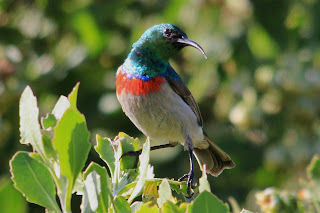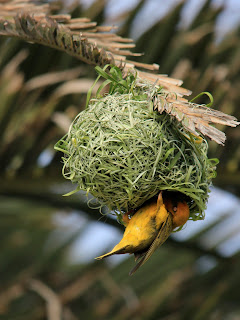 |
| Southern Double-Collared Sunbird |
Convergent evolution? The theory that explains how hummingbirds look like very similar to sunbirds - but the hummers hang out in the Americas and belong to the same family as swifts while the sunny guys are found in Africa and Asia and belong to the same family as most perching birds.
Possible. But not as convincing as my ground-breaking new theory honed during a two-week return drive from Cape Town to Port Elizabeth: the Creators' Colouring Book Principle.
In the Beginning, Grand Fauna Designers of each continent were handed the same colouring book template by the Creator In Chief and given free hand to do whatever they liked. It just so happened that we got a celestial Coco Chanel while Africa got Vivienne Westwood.
So South Africa has the Red-nobbed Coot: virtually identical to the familiar "bald-as-a" bird seen everywhere in Britain - but with two comedy red knobs on top of its head.
Cape Sparrow: our very own House Sparrow wearing a fetching bandit's mask.
Red-winged Starling: like our common or garden blackbird with go-faster splashes of red on its wings.
Black African Oystercatcher: the black-and-white bird of British coasts given a stylish all-black respray with stand-out red bill and legs. (But while ours are thriving, the African version is in trouble.)
Speckled Mousebird: to our Long-tailed Tit - "That's not a tail; now that's a tail."
Olive-breasted Thrush: forget the brown dots on a brown breast with brown wings on our Song Thrush - how about a splash of dazzling orange on autumnal green and slate grey?
Cape Longclaw: no to the streaky dark brown stripes and streaky light brown heads of our pipits - let's go for a bright orange throat set-off with a bold black border.
And the Cape Weaver: a bright, canary-yellow alternative to our black, speckly starlings - and these boys weave their own nests on the end of palm tree leaves, too.
I'm not sure Richard Dawkins would agree and it needs a bit of work. Maybe a research grant from the Mid-West University of Creationism. But what do you think?








No comments:
Post a Comment